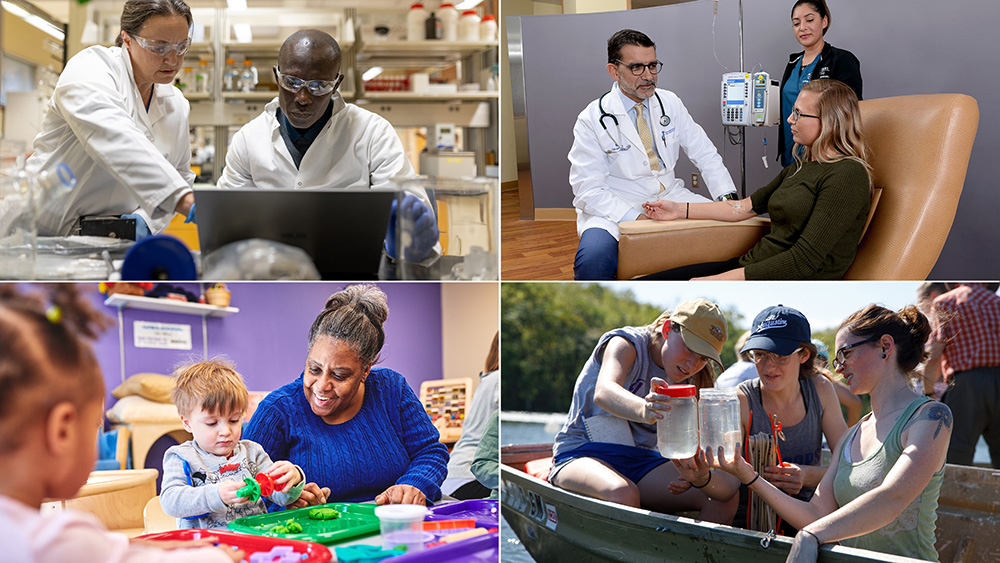KU research employs more than 4,100 on campus, buys $53.9M in goods and services from Kansas companies

LAWRENCE — Sponsored research at the University of Kansas supported the salaries of 4,182 people in 2022 and accounted for $53.9 million in spending with Kansas companies on research-related goods and services, according to a new report. About 33% of research-funded employees were students, and about 20% were faculty.
“KU research addresses problems of worldwide significance while delivering solutions that make a difference to Kansas and the region. That research is supported in large part by external grant dollars that researchers spend in Kansas, fueling the economy and investing in communities across the state,” said Simon Atkinson, vice chancellor for research on KU’s Lawrence campus. “We value our mutually beneficial partnerships with Kansas businesses and organizations, and we hope to expand those relationships in the future.”
The report, produced by the Institute for Research on Innovation & Science, also details the geographic distribution of KU research-related spending. In 2022, KU pumped research-related revenue into 93 of 105 Kansas counties, and vendors in each of 15 of those counties received more than $100,000 in purchases. Douglas County topped the list, with expenditures around $35.9 million.
Additional IRIS reporting shows that KU contributed $952.8 million to the U.S. economy between 2011 and 2021, with spending from external research funding flowing to 6,309 vendors and subcontractors over that time. Of these, nearly 900 were small businesses. Some 575 vendors were minority- or women-owned businesses, which attracted more than $27 million in research spending from KU.
The IRIS reports encompass research spending across all KU campuses. That includes the KU Medical Center in Kansas City, Kansas, where research purchases ultimately contribute to life-changing medical advances.
“The KU Medical Center engages in a broad array of research up to the point of introducing new therapies into the clinic and distributing them beyond the university. These advances make a huge difference in the lives of Kansans,” said Dr. Matthias Salathe, vice chancellor for research at the medical center. “We are committed to working tirelessly to continue pushing the boundaries of discovery for the benefit of everyone in our state.”
KU’s research-related economic impact extends beyond the data captured in IRIS reporting. For example, 44 active startup companies have spun out of KU or are based on KU technologies, and 25 of those companies are located in Kansas. Through the university’s relationship with the KU Innovation Park, KU researchers help attract businesses to Lawrence, Kansas City and the surrounding area — companies like Archer Daniels Midland and Garmin — who want to be close to KU researchers and students. The park system, which extends to the medical center campus, includes 65 companies and accounts for more than 600 private sector jobs and $40.5 million in annual direct payroll.
IRIS is a national consortium of research universities organized around an IRB-approved data repository, housed at the Institute for Social Research at the University of Michigan.
“Our reports clarify and explain the economic impact of university research through many different lenses,” said IRIS Executive Director Jason Owen-Smith, a professor of sociology and executive director for research analytics at the University of Michigan. “Through these data-driven reports, our goal is to better understand and explain — and ultimately improve — the public value of higher education and research.”
IRIS reports are based on administrative data that KU supplies to IRIS, which are then merged with other public and private datasets. Reports are available to IRIS members. No individual businesses, employees or students are identifiable in the reports.
Nearly 500 researchers from more than 100 institutions have accessed IRIS data through its virtual data enclave, and more than 40 published papers and three books have used the data.
Photo: KU researchers work in laboratories, clinics, ecological field sites, schools and countless other settings to make discoveries that benefit people in Kansas and beyond. Their research spending also helps fuel the state’s economy. Credit: KU Marketing, Frontiers: KU Clinical & Translational Science Institute.